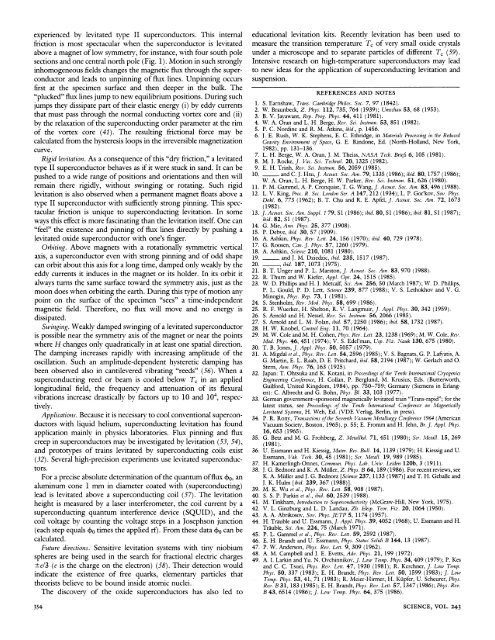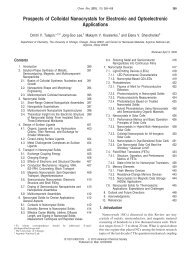Levitation in Physics
Levitation in Physics
Levitation in Physics
You also want an ePaper? Increase the reach of your titles
YUMPU automatically turns print PDFs into web optimized ePapers that Google loves.
experienced by levitated type II superconductors. This <strong>in</strong>ternal<br />
friction is most spectacular when the superconductor is levitated<br />
above a magnet of low symmetry, for <strong>in</strong>stance, with four south pole<br />
sections and one central north pole (Fig. 1). Motion <strong>in</strong> such strongly<br />
<strong>in</strong>homogeneous fields changes the magnetic flux through the superconductor<br />
and leads to unp<strong>in</strong>n<strong>in</strong>g of flux l<strong>in</strong>es. Unp<strong>in</strong>n<strong>in</strong>g occurs<br />
first at the specimen surface and then deeper <strong>in</strong> the bulk. The<br />
"plucked" flux l<strong>in</strong>es jump to new equilibrium positions. Dur<strong>in</strong>g such<br />
jumps they dissipate part of their elastic energy (i) by eddy currents<br />
that must pass through the normal conduct<strong>in</strong>g vortex core and (ii)<br />
by the relaxation of the superconduct<strong>in</strong>g order parameter at the rim<br />
of the vortex core (41). The result<strong>in</strong>g frictional force may be<br />
calculated from the hysteresis loops <strong>in</strong> the irreversible magnetization<br />
curve.<br />
Rigid levitation. As a consequence of this "dry friction," a levitated<br />
type II superconductor behaves as if it were stuck <strong>in</strong> sand. It can be<br />
pushed to a wide range of positions and orientations and then will<br />
rema<strong>in</strong> there rigidly, without sw<strong>in</strong>g<strong>in</strong>g or rotat<strong>in</strong>g. Such rigid<br />
levitation is also observed when a permanent magnet floats above a<br />
type II superconductor with sufficiently strong p<strong>in</strong>n<strong>in</strong>g. This spectacular<br />
friction is unique to superconduct<strong>in</strong>g levitation. In some<br />
ways this effect is more fasc<strong>in</strong>at<strong>in</strong>g than the levitation itself. One can<br />
"feel" the existence and p<strong>in</strong>n<strong>in</strong>g of flux l<strong>in</strong>es directly by push<strong>in</strong>g a<br />
levitated oxide superconductor with one's f<strong>in</strong>ger.<br />
Orbit<strong>in</strong>g. Above magnets with a rotationally symmetric vertical<br />
axis, a superconductor even with strong p<strong>in</strong>n<strong>in</strong>g and of odd shape<br />
can orbit about this axis for a long time, damped only weakly by the<br />
eddy currents it <strong>in</strong>duces <strong>in</strong> the magnet or its holder. In its orbit it<br />
always turns the same surface toward the symmetry axis, just as the<br />
moon does when orbit<strong>in</strong>g the earth. Dur<strong>in</strong>g this type of motion any<br />
po<strong>in</strong>t on the surface of the specimen "sees" a time-<strong>in</strong>dependent<br />
magnetic field. Therefore, no flux will move and no energy is<br />
dissipated.<br />
Switng<strong>in</strong>g. Weakly damped sw<strong>in</strong>g<strong>in</strong>g of a levitated superconductor<br />
is possible near the symmetry axis of the magnet or near the po<strong>in</strong>ts<br />
where H changes only quadratically <strong>in</strong> at least one spatial direction.<br />
The damp<strong>in</strong>g <strong>in</strong>creases rapidly with <strong>in</strong>creas<strong>in</strong>g amplitude of the<br />
oscillation. Such an amplitude-dependent hysteretic damp<strong>in</strong>g has<br />
been observed also <strong>in</strong> cantilevered vibrat<strong>in</strong>g "reeds" (56). When a<br />
superconduct<strong>in</strong>g reed or beam is cooled below T, <strong>in</strong> an applied<br />
longitud<strong>in</strong>al field, the frequency and attenuation of its flexural<br />
vibrations <strong>in</strong>crease drastically by factors up to 10 and 104, respectively.<br />
Applications. Because it is necessary to cool conventional superconductors<br />
with liquid helium, superconduct<strong>in</strong>g levitation has found<br />
application ma<strong>in</strong>ly <strong>in</strong> physics laboratories. Flux p<strong>in</strong>n<strong>in</strong>g and flux<br />
creep <strong>in</strong> superconductors may be <strong>in</strong>vestigated by levitation (53, 54),<br />
and prototypes of tra<strong>in</strong>s levitated by superconduct<strong>in</strong>g coils exist<br />
(32). Several high-precision experiments use levitated superconductors.<br />
For a precise absolute determ<strong>in</strong>ation of the quantum offlux ¢o, an<br />
alum<strong>in</strong>um cone 1 mm <strong>in</strong> diameter coated with (superconduct<strong>in</strong>g)<br />
lead is levitated above a superconduct<strong>in</strong>g coil (57). The levitation<br />
height is measured by a laser <strong>in</strong>terferometer, the coil current by a<br />
superconduct<strong>in</strong>g quantum <strong>in</strong>terference device (SQUID), and the<br />
coil voltage by count<strong>in</strong>g the voltage steps <strong>in</strong> a Josephson junction<br />
(each step equals 4o times the applied rf). From these data 4o can be<br />
calculated.<br />
Future directions. Sensitive levitation systems with t<strong>in</strong>y niobium<br />
spheres are be<strong>in</strong>g used <strong>in</strong> the search for fractional electric charges<br />
±e/3 (e is the charge on the electron) (58). Their detection would<br />
<strong>in</strong>dicate the existence of free quarks, elementary particles that<br />
theorists believe to be bound <strong>in</strong>side atomic nuclei.<br />
The discovery of the oxide superconductors has also led to<br />
354<br />
educational levitation kits. Recently levitation has been used to<br />
measure the transition temperature T, of very small oxide crystals<br />
under a microscope and to separate particles of different T, (59).<br />
Intensive research on high-temperature superconductors may lead<br />
to new ideas for the application of superconduct<strong>in</strong>g levitation and<br />
suspension.<br />
REFERENCES AND NOTES<br />
1. S. Earnshaw, Trans. Cambridge Philos. Soc. 7, 97 (1842).<br />
2. W. Braunbeck, Z. Phys. 112, 735, 764 (1939); Umschau 53, 68 (1953).<br />
3. B. V. Javawant, Rep. Prog. Phys. 44, 411 (1981).<br />
4. W. A. Oran and L. H. Berge, Rev. Sci. Itnstru<strong>in</strong>. 53, 851 (1982).<br />
5. P. C. Nord<strong>in</strong>e and R. M. Atk<strong>in</strong>s, ibid., p. 1456.<br />
6. J. E. Rush, W. K. Stephens, E. C. Ethridge, <strong>in</strong> Materials Process<strong>in</strong>g <strong>in</strong> the Redlced<br />
Gravity Etnvirontment of Space, G. E. R<strong>in</strong>done, Ed. (North-Holland, New York,<br />
1982), pp. 131-136.<br />
7. L. H. Berge, W. A. Oran, J. M. Theiss, NASA Tech. Briefs 6, 105 (1981).<br />
8. M. J. Rocke, J. Vac. Sci. Technol. 20, 1325 (1982).<br />
9. E. H. Tr<strong>in</strong>h, Rev. Sci. Instnim. 56, 2059 (1985).<br />
10. _ _ and C. J. Hsu,J. Acoust. Soc. Am. 79, 1335 (1986); ibid. 80, 1757 (1986);<br />
W. A. Oran, L. H. Berge, H. W. Parker, Rev. Sci. Instn4m. 51, 626 (1980).<br />
11. P. M. Gammel, A. P. Cronquist, T. G. Wang, J. Acotust. Soc. Amn. 83, 496 (1988).<br />
12. L. V. K<strong>in</strong>g, Proc. R. Soc. Lotndotn Ser. A 147, 212 (1934); L. P. Gor'kov, Sov. Phys.<br />
Dokl. 6, 773 (1962); B. T. Chu and R. E. Apfel, J. Acoust. Soc. Am. 72, 1673<br />
(1982).<br />
13. J. Acouist. Soc. Am. Suppl. 1 79, SI (1986); ibid. 80, Si (1986); ibid. 81, SI (1987);<br />
ibid. 82, SI (1987).<br />
14. G. Mie, Atnn. Phys. 25, 377 (1908).<br />
15. P. Debve, ibid. 30, 57 (1909).<br />
16. A. Ashk<strong>in</strong>, Phys. Rev. Lett. 24, 156 (1970); ibid. 40, 729 (1978).<br />
17. G. Roosen, Can.J. Phys. 57, 1260 (1979).<br />
18. A. Ashk<strong>in</strong>, Scietnce 210, 1081 (1980).<br />
19. and J. M. Dziedzic, ibid. 235, 1517 (1987).<br />
20. _ ibid. 187, 1073 (1975).<br />
21. B. T. Unger and P. L. Marston, J. Acoust. Soc. Am. 83, 970 (1988).<br />
22. R. Thurn and W. Kiefer, Appl. Opt. 24, 1515 (1985).<br />
23. W. D. Phillips and H. J. Metcalf, Sci. Am. 256, 50 (March 1987); W. D. Phillips,<br />
P. L. Gould, P. D. Lett, Scietnce 239, 877 (1988); V. S. Lethokhov and V. G.<br />
M<strong>in</strong>og<strong>in</strong>, Phys. Rep. 73, 1 (1981).<br />
24. S. Stenholm, Rev. Mod. Phys. 58, 699 (1986).<br />
25. R. F. Wuerker, H. Shelton, R. V. Langmuir, J. Appl. Phys. 30, 342 (1959).<br />
26. S. Arnold and H. Nessel, Rev. Sci. Instnon. 56, 2066 (1985).<br />
27. S. Arnold and L. M. Folan, ibid. 57, 2250 (1986); ibid. 58, 1732 (1987).<br />
28. H. W. Knobel, Cotntrol Eng. 11, 70 (1964).<br />
29. M. W. Cole and M. H. Cohen, Phys. Rev. Lett. 23, 1238 (1969); M. W. Cole, Rev.<br />
Mod. Phys. 46, 451 (1974); V. S. Edel'man, Usp. Fiz. NYauk 130, 675 (1980).<br />
30. T. B. Jones, J. Appl. Phys. 50, 5057 (1979).<br />
31. A. Migdal et al., Phys. Rev. Lett. 54, 2596 (1985); V. S. Bagnats, G. P. Lafvatis, A.<br />
G. Mart<strong>in</strong>, E. L. Raab, D. E. Pritchard, ibid. 58, 2194 (1987); W. Gerlach and 0.<br />
Stern, AnnZ. Phys. 76, 163 (1925).<br />
32. Japan: T. Ohtsuka and K. Kotani, <strong>in</strong> Proceed<strong>in</strong>igs ofthe Tenth Interniational Cryogenics<br />
Engitneeritng Cotlferetnce, H. Collan, P. Berglund, M. Krusius, Eds. (Butterworth,<br />
Guilford, United K<strong>in</strong>gdom, 1984), pp. 750-759; Germanv (Siemens <strong>in</strong> Erlangen):<br />
C. Albrecht and G. Bohn, Phys. Bl. 33, 103 (1977).<br />
33. German government-sponsored magneticallv levitated tra<strong>in</strong> "Trans-rapid"; for the<br />
latest status, see Proceed<strong>in</strong>gs of the Tenth Inteniatiotnal Cotnferentce oni Magnetically<br />
Levitated Systemns, H. Weh, Ed. (VDE Verlag, Berl<strong>in</strong>, <strong>in</strong> press).<br />
34. P. R. Ronv, Transactiotns of the Seventh Vacuum Metallurgy Cotnference 1964 (American<br />
Vacuum Society, Boston, 1965), p. 55; E. Fromm and H. Jehn, Br.J. Appl. Phys.<br />
16, 653 (1965).<br />
35. G. Betz and M. G. Frohberg, Z. Metallkd. 71, 451 (1980); Scr. Metall. 15, 269<br />
(1981).<br />
36. U. Essmann and H. Kiessig, Mater. Res. Bull. 14, 1139 (1979); H. Kiessig and U.<br />
Essmann, Vak. Tech. 30, 45 (1981); Scr. Metall. 19, 989 (1985).<br />
37. H. Kamerl<strong>in</strong>gh-Onnes, Comnitt. Phys. Lab. Ulniv. Leiden 120b, 3 (1911).<br />
38. J. G. Bednorz and K. A. Muller, Z. Phys. B 64, 189 (1986). For recent reviews, see<br />
K. A. Muller and J. G. Bednorz [Science 237, 1133 (1987)] and T. H. Geballe and<br />
J. K. Hulm [ibid. 239, 367 (1988)].<br />
39. M. K. Wu et al., Phys. Rev. Lett. 58, 908 (1987).<br />
40. S. S. P. Park<strong>in</strong> et al., ibid. 60, 2539 (1988).<br />
41. M. T<strong>in</strong>kham, Introductiont to Superconductivity (McGraw-Hill, New York, 1975).<br />
42. V. L. G<strong>in</strong>zburg and L. D. Landau, Zh. Eksp. Teor. Fiz. 20, 1064 (1950).<br />
43. A. A. Abrikosov, Sov. Phys.JETP 5, 1174 (1957).<br />
44. H. Trauble and U. Essmann, J. Appl. Phys. 39, 4052 (1968); U. Essmann and H.<br />
Trauble, Sci. Amn. 224, 75 (March 1971).<br />
45. P. L. Gammel et al., Phys. Rev. Lett. 59, 2592 (1987).<br />
46. E. H. Brandt and U. Essmann, Phys. Status Solidi B 144, 13 (1987).<br />
47. P. W. Anderson, Phys. Rev. Lett. 9, 309 (1962).<br />
48. A. M. Campbell and J. E. Evetts, Adv. Phys. 21, 199 (1972).<br />
49. A. I. Lark<strong>in</strong> and Yu. N. Ovch<strong>in</strong>nikov,J. Low Temnp. Phys. 34, 409 (1979); P. Kes<br />
and C. C. Tsuei, Phys. Rev. Lett. 47, 1930 (1981); R. Kerchner, J. Low Temnp.<br />
Phys. 50, 337 (1983); E. H. Brandt, Phys. Rev. Lett. 50, 1599 (1983); J. Low<br />
Tetnp. Phys. 53, 41, 71 (1983); R. Meier-Hirmer, H. Kupfer, U. Scheurer, Phys.<br />
Rev. B 31, 183 (1985); E. H. Brandt, Phys. Rev. Lett. 57, 1347 (1986); Phys. Rev.<br />
B 43, 6514 (1986); J. Low Temnp. Phys. 64, 375 (1986).<br />
SCIENCE, VOL. 243
















